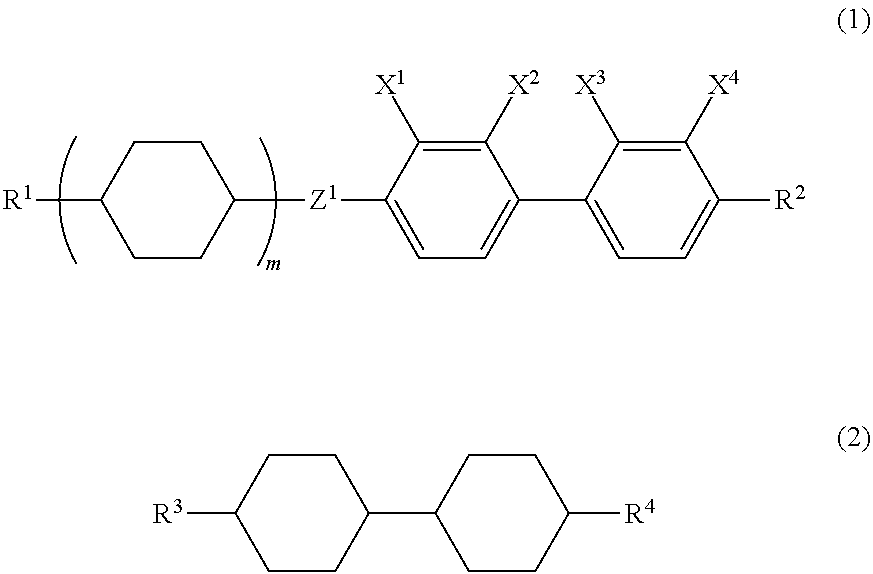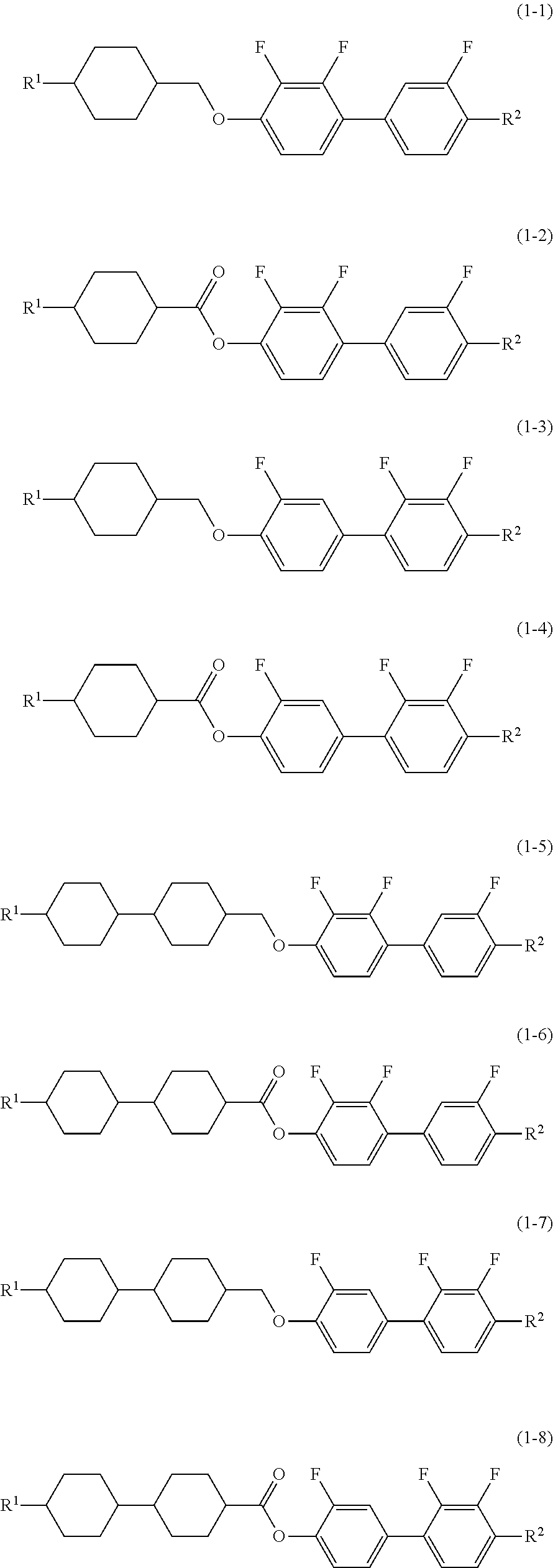[0012]One of the advantages of the invention is to provide a liquid
crystal composition that satisfies at least one characteristic among the characteristics such as a high
maximum temperature of a nematic phase, a low minimum temperature of a nematic phase, a low
viscosity, a suitable
optical anisotropy, a negatively large
dielectric anisotropy, a large
specific resistance, a high stability to
ultraviolet light and a high stability to heat. Another
advantage of the invention is to provide a liquid crystal composition that is suitably balanced regarding at least two characteristics. A further
advantage of the invention is to provide a
liquid crystal display device that contains the liquid crystal composition. An additional
advantage of the invention is to provide a liquid crystal composition that has a suitable
optical anisotropy that is a small optical anisotropy or a large optical anisotropy, a negatively large
dielectric anisotropy, a high stability to
ultraviolet light and so forth, and is to provide an AM device that has a short
response time, a
high voltage holding ratio, a
high contrast ratio, a long service life and so forth.
[0013]The terms used in the specification and claims are defined as follows. The liquid crystal composition and the
liquid crystal display device of the invention may occasionally be abbreviated to “the composition” and “the device,” respectively. A liquid
crystal display device is a generic term for a liquid
crystal display panel and a liquid
crystal display module. The “liquid crystal compound” is a generic term for a compound having a liquid crystal phase such as a nematic phase and a smectic phase, and also for a compound having no liquid crystal phase but being useful as a component of a composition. The useful compound has a 6-membered ring such as 1,4-cyclohexylene and 1,4-
phenylene, and a rod-like molecular structure. An
optically active compound and a polymerizable compound may occasionally be added to the composition. Even in the case where these compounds are liquid crystal compounds, the compounds are classified as an additive herein. At least one compound selected from a group of compounds represented by formula (1) may occasionally be abbreviated to “the compound (1).”“The compound (1)” means one compound, or two or more compounds represented by formula (1). The same rules apply to compounds represented by the other formulas. “Arbitrary” is used not only in cases when the position is arbitrary but also in cases when the number is arbitrary, however, is not used in cases when the number is zero.
[0014]A higher limit of the temperature range of a nematic phase may occasionally be abbreviated to “a
maximum temperature.” A
lower limit of the temperature range of a nematic phase may occasionally be abbreviated to “a minimum temperature.” That “a
specific resistance is large” means that a composition has a large specific resistance at
room temperature and also at a temperature close to the maximum temperature of a nematic phase in the initial stage, and that the composition has a large specific resistance at
room temperature and also at a temperature close to the maximum temperature of a nematic phase even after it has been used for a long time. That “a
voltage holding ratio is high” means that a device has a
high voltage holding ratio at
room temperature and also at a temperature close to the maximum temperature of a nematic phase in the initial stage, and that the device has a high
voltage holding ratio at room temperature and also at a temperature close to the maximum temperature of a nematic phase even after it has been used for a long time. When characteristics such as optical anisotropy are explained, values which are obtained according to the measuring methods described in Examples will be used. A first component means one compound, or two or more compounds. “A ratio of the first component” means the percentage by weight (% by weight) of the first component based on the total weight of the liquid crystal composition. The same rule applies to a ratio of the second component and so forth. A ratio of an additive mixed into the composition means the percentage by weight (% by weight) or weight parts per million (ppm) based on the total weight of the liquid crystal composition.
[0015]The symbol R1 is used for a plurality of compounds in the chemical formulas of component compounds. R1 may be identical or different in two arbitrary ones of the compounds. In one case, for example, R1 of the compound (1) is ethyl and R1 of the compound (4-1) is ethyl. In another case, R1 of the compound (1) is ethyl and R1 of the compound (4-1) is propyl. The same rule applies to the symbols R2, Z3, and so forth.
[0017][1] A liquid crystal composition having a negative dielectric anisotropy that includes at least one compound selected from the group of compounds represented by formula (1) as a first component and at least one compound selected from the group of compounds represented by formula (2) as a second component:wherein R1, R2 and R4 are each independently
alkyl having 1 to 12 carbons, alkoxy having 1 to 12 carbons, alkenyl having 2 to 12 carbons, or alkenyl having 2 to 12 carbons in which arbitrary
hydrogen is replaced by
fluorine; R3 is independently alkenyl having 2 to 12 carbons; Z1 is independently
ethylene, methyleneoxy or carbonyloxy X1 and X4 are each independently
fluorine or
chlorine; one of X2 and X3 is
hydrogen and the other is
fluorine or
chlorine; m 1 or 2.
[0018][2] The liquid crystal composition according to item 1, wherein the first component is at least one compound selected from the group of compounds represented by formulas (1-1) and (1-8):wherein R1 and R2 are each independently
alkyl having 1 to 12 carbons, alkoxy having 1 to 12 carbons, alkenyl having 2 to 12 carbons, or alkenyl having 2 to 12 carbons in which arbitrary
hydrogen is replaced by fluorine.
 Login to View More
Login to View More 


